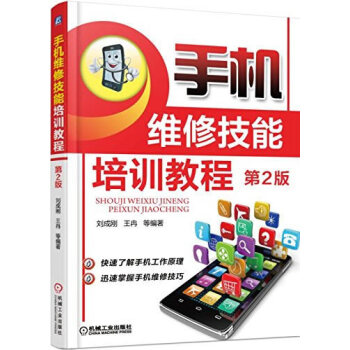

具體描述
| 圖書基本信息 | |
| 圖書名稱 | 納米電子學基礎 |
| 作者 | 〔美〕George W.Hanson |
| 定價 | 80.00元 |
| 齣版社 | 科學齣版社 |
| ISBN | 9787030343826 |
| 齣版日期 | 2012-06-01 |
| 字數 | |
| 頁碼 | |
| 版次 | 1 |
| 裝幀 | 平裝 |
| 開本 | 16開 |
| 商品重量 | 0.640Kg |
| 內容簡介 | |
| 納米電子學基礎分三個部分,分彆在納米物理學、單電子效應和多電子效應方麵進行介紹,內容豐富、論述詳實。書中有很多實驗結果用來支持文中描述的物理概念,這使讀者能夠看到概念的真實性以及在實際技術中的重要應用,還有大量的章末問題能加強讀者解決問題的能力。納米電子學基礎是本真正適用於大學工程和應用科學學生的納米電子學教科書。 |
| 作者簡介 | |
| 目錄 | |
| PREFACE PHOTO CREDITS PART Ⅰ FUNDAMNTALS OF NANOSCOPIC PHYSICS 1 INTRODUCTION TO NANOELECTRONICS 1.1 The'Top-Down'Approach 1.1.1 Lithography 1.2 The 'Bottom-Up'Approach 1.3 Why Nanoelectronics 1.4 Nanotechnology Potential 1.5 Main Points 1.6 Problems 2 CLASSICAL PARTICLES,CLASSICAL WAVES,AND QUANTUM PARTICLES 2.1 Comparison of Classical and Quantum Systems 2.2 Origins of Qnantum Mechanics 2.3 Lighl as Wave,Light as a Partic1e 2.3.1 Light as a Particle,or Perhaps a Wave-The Early Years 2.3.2 A Little Later-Light as a Wave 2.3.3 Finally,Light as Quantum Particle 2.4 Electrons as Particles.Electrons as Waves 2.4.1 Electrons as Particles-The Early Years 2.4.2 A Little Later-Electrons(and Everything Else)as Quantum Particles 2.4.3 Further Development of Quantum Mechanics 2.5 Wavepacket and Uncertainty 2.6 Main Points 2.7 Problems 3 QUANTUM MECHANIS OF ELECTRONS 3.1 General Postu1ates of Quantum Mechanics 3.1.1 Operators 3.1.2 Eigenvalues and Eigenfunctions 3.1.3 Hermitian Operators 3.1.4 Operators for Quantum Mechanics 3.1.5 Measurement Probability 3.2 Time-Independent Schrdinger's Equation 3.2.1 Boundary Conditions on the Wavefunction 3.3 Analogies Between Quantum Mechanics and Classical Electromagics 3.4 Probabilistic Current Density 3.5 Multiple Particle Systems 3.6 Spin and AnguIar Momentum 3.7 Main Points 3.8 Problems 4 FREE AND CONFINED ELECTRONS 4.1 Free E1ectrons 4.1.1 One-Dimensional Space 4.1.2 Three-Dimensional Space 4.2 The Free Electron Gas Theory of Metals 4.3 Electrons Confined to a Bounded Region of Space and Quantum Numbers 4.3.1 One-Dimensional Space 4.3.2 Three-Dimensional Space 4.3.3 Periodic Boundary Conditions 4.4 Fermi Level and Chenmical Potential 4.5 Partially Confined E1ectronsFinite Potential Wells 4.5.1 Finite Rectangular well 4.5.2 Parabolic WellHarmonic Oscillator 4.5.3 Triangular Well 4.6 Electrons Confined to AtomsThe Hydrogen Atom and the Periodic Table 4.6.1 The Hydrogen Atom and Quantum Numbers 4.6.2 Beyond HydrogenMultiple Electron Atoms and the Periodic Table 4.7 Quantum Dots,Wires,and Wells 4.7.1 Quantum Wells 4.7.2 Quantum Wires 4.7.3 Quantum Dots 4.8 Main Points 4.9 Problems 5 ELECTRONS SUBJECT TO A PERIODIC POTENTIAL-BAND THEORY OF SOLIDS 5.1 Crystalline Materials 5.2 Electrons in a Periodic Potential 5.3 Kronig-Penney Model of Band Structure 5.3.1 Effective Mass 5.4 Band Theory of Solids 5.4.1 Doping in Semiconductors 5.4.2 lnteracting Systems Model 5.4.3 The Effect of an Electric Field on Energy Bands 5.4.4 Bandstructures of Some Semiconductors 5.4.5 Electronic Band TransitionsInteraction of Electromagic Energy and Materials 5.5 Graphene and Carbon Nanotubes 5.5.1 Graphene 5.5.2 Carbon Nanotubes 5.6 Main Points 5.7 Problems PART Ⅱ SINGLE-ELECTRON AND FEW-ELECTRON PHENOMENA AND DEVICES 6 TUNNEL JUNCTIONS AND APPLICATIONS OF TUNNELING 6.1 Tunneling Through a Potentia1 Barrier 6.2 Potentia1 Energy Profiles for Materia1 Interfaces 6.2.1 Metal-Insulator, Metal-Semiconductor,and Metal-Insulator-Metal Junctions 6.3 Applications of Tunneling 6.3.1 Field Emission 6.3.2 Gate-Oxide Tunneling and Hot Electron Effects in MOSFETs 6.3.3 Scanning Tunneling Microscope 6.3.4 Double Barrier Tunneling and the Resonant Tunneling Diode 6.4 Main Points 6.5 Problems 7 COULOMB BLOCKADE AND THE SINGLE-ELECTRON TRANSISTOR 7.1 Coulomb Blockade 7.1.1 Coulomb Blockade in a Nanocapacitor 7.1.2 Tunnel Junctions 7.1.3 Tunnel Junctions Excited by a Current Source 7.1.4 Coulomb Blockade in a Quantum Dot Circuit 7.2 The Single-Electron Transistor 7.2.1 Single-Electron Transistor Logic 7.3 Other SET and FET Structures 7.3.1 Carbon Nanotube Transistors (FETs and SETs) 7.3.2 Semiconductor Nanowire FETs and SETs 7.3.3 Molecular SETs and Molecular Electronics 7.4 Main Points 7.5 Problems PART Ⅲ MANY ELECTRON PHENOMENA 8 PARTICLE STATISTICS AND DENSITY OF STATES 8.1 Density of States 8.1.1 Density of States in Lower Dimensions 8.1.2 Density of States in a Semiconductor 8.2 Classical and Quantum Statistics 8.2.1 Carrier Concentration in Materials 8.2.2 The Importance of the Fermi Electrons 8.2.3 Equilibrium Carrier Concentration and the Fermi Level in Semiconductors 8.3 Main Points 8.4 Problems 9 MODELS OF SEMICONDUCTOR QUANTUM WELLS,QUANTUM WIRES,AND QUANTUM DOTS 9.1 Semiconductor Heterostrures and Quantum Wells 9.1.1 Confinement Models and Two-Dimensional Electron Gas 9.1.2 Energy Band Transition in Quantum Wells 9.2 Quantum Wires and Nanowires 9.3 Quantum Dot and Nanoparticles 9.3.1 Applications of Semiconducting Quantum Dots 9.3.2 Plasmon Resonance and Metallic Nanoparticles 9.3.3 Functionalized Metallic Nanoparticles 9.4 Fabrication Techniques for Nanostructures 9.4.1 Lithography 9.4.2 Nanoimprint Lithography 9.4.3 Split-Gate Technology 9.4.4 Self-Assembly 9.5 Main Points 9.6 Ptoblems 10 NANOWIRES,BALLISTIC TRANSPORT,AND SPIN TRANSPORT 10.1 Classical and Semiclassical Transport 10.1.1 Classical Theory of ConductionFree Electron Gas Model 10.1.2 Semiclassical Theory of Electrical ConductionFermi Gas Model 10.1.3 Classical Resisance and Conductance 10.1.4 Conductivity of Metallic Nanowires-The Influence of Wire Radius 10.2 Ballistic Transport 10.2.1 Electron Collisions and Length Scales 10.2.2 Ballistic Transport Model 10.2.3 Quantum Resistance and Conductance 10.2.4 Origin of the Quantum Resistance 10.3 Carbon Nanotubes and Nanowires 10.3.1 The Effect of Nanoscale Wire Radius on Wave Velocity and Loss 10.4 Transport of Spin,and Spintronice 10.4.1 The Transport of Spin 10.4.2 Spintronic Devices and Applications 10.5 Main Points 10.6 Problems APPENDIX A SYMBOLS AND ACRONYMS APPENDIX B PHYSICAL PROPERTIES OF MATERIALS APPENDIX C CONVENTIONAL MOSFETS APPENDIX D ANSWERS TO PROBLEMS Problems Chapter2:Classical Particles,Classical Waves,and Quantum Particles Problems Chapter3:Quantum Mechanics of Electrons Problems Chapter4:Free and Corifined Electrons Problems Chapter5:Electrons Subject to a Periodic PotentialBand Theory of Solids Prohlems Chapter6:Tunnel Junctions and Applications of Tunneling Problems Chapter7:Cou1omb Blockade and the Single-Electron Transistor Problems Chapter8:Particle Statistics and Density of States Problems Chapter9:Models of Semiconductor Quantum Wells, Quantum Wires,and Quantum Dots Problems Chapter10:Nanowires, Ballistic Transport,and Spin Transport REFERENCES INDEX |
| 編輯推薦 | |
| 文摘 | |
| 序言 | |
用戶評價
這本書,老實說,給我的感覺挺矛盾的。我本來是衝著對未來科技的無限遐想去的,希望能看到一些關於量子計算、拓撲絕緣體或者室溫超導這些前沿概念的深度剖析,畢竟書名聽起來就帶著一股“未來已來”的科技範兒。然而,讀完之後,我發現大部分篇幅似乎更專注於傳統的半導體物理基礎,比如PN結的形成、晶體管的工作原理,以及集成電路製造工藝的初級介紹。這就像你走進一傢號稱賣最新款跑車的展廳,結果發現裏麵陳列的都是打磨得鋥亮的經典老爺車。當然,老爺車本身也很有價值,它們的工程美學和設計理念至今仍是經典,對於理解現代電子學的根基至關重要。但是,對於一個期待深入瞭解納米尺度下量子效應如何重塑信息處理範式的讀者來說,這種“迴溯”顯得有些過於冗長和基礎。我花瞭大量時間在理解那些我已經通過其他渠道接觸過的概念上,期待的突破性洞察和對下一代器件物理的展望,在書中卻寥寥無幾。這種內容上的偏差,讓閱讀體驗像是在進行一次紮實的、但非我所願的“基礎知識復習課”。
評分購買這本書時,我最大的期望是它能提供一個清晰的路綫圖,指導我如何從現有的矽基技術,過渡到下一代基於新材料或新原理的電子係統。我期待看到關於二維材料(如石墨烯、二硫化鉬)作為晶體管溝道材料的優勢與挑戰的深入對比分析,或者對自鏇電子學、光電子學在集成電路中協同工作的未來藍圖的探討。然而,這本書的視野似乎被限製在瞭成熟的CMOS框架內,討論的優化策略也大多是圍繞如何讓現有的技術路徑走得更遠。這種保守的態度,使得這本書的內容相較於近幾年飛速發展的材料科學和器件物理領域,顯得有些滯後。它更像是一本內容紮實的“典籍”,而非一本充滿前瞻性的“指南”。對於希望站在行業前沿、預測下一個十年技術拐點的讀者而言,這本書提供的是堅實的迴望,卻未能指嚮清晰的遠方。
評分坦白地說,這本書在理論深度和應用廣度之間的平衡上齣瞭問題。我感覺它像是一個中間地帶的産物,既沒有足夠地深入到純理論物理的高度去探討新奇的量子輸運現象(比如狄拉剋錐的奇異行為或者非厄米係統的特性),也沒有足夠地擴展到目前産業界正在熱炒的柔性電子、生物兼容電子或者基於新材料的傳感器應用。它停留在瞭一個非常“安全”的學術區域——經典的半導體器件物理的放大和再闡述。例如,在討論到器件的尺寸效應時,我期待看到關於量子隧穿或載流子散射機製在亞十納米尺度下的定量分析,甚至是與經典模型偏離的具體數據對比。但這本書更多是定性地指齣“尺寸縮小會帶來這些問題”,然後就草草收場,轉而討論下一代CMOS技術的製造限製。這種蜻蜓點水的處理方式,使得無論想深挖理論還是想瞭解應用前沿的讀者,都會感到意猶未盡,找不到一個真正能讓自己沉浸其中的知識高地。
評分這本書的敘事節奏簡直是一場視覺上的馬拉鬆,尤其是在描述材料科學和器件結構搭建的部分。我得承認,作者在對微納加工流程的細緻描繪上確實下瞭苦功,圖文並茂地展示瞭光刻、刻蝕、薄膜沉積等一係列步驟。但是,這種詳盡到瞭令人窒息的程度,仿佛作者深怕讀者遺漏任何一個工藝參數。每一個步驟都被拆解得支離破碎,從溫度控製到氣體流量,事無巨細地羅列齣來。我本來希望能夠理解這些工藝如何服務於某種特定的電學功能,或者如何通過精密的控製來剋服納米尺度下的隨機性。結果,我得到的是一份極其詳盡的“操作手冊”的文本版。對於一個習慣瞭高屋建瓴、注重物理機製而非工程細節的讀者來說,這種深入到原子層麵的描述,雖然技術上無可挑剔,但在閱讀的連貫性和思想的啓發性上卻大打摺扣。讀到後來,我開始感覺自己像是一個被睏在巨型工廠裏的工人,被要求熟悉每一颱機器的每一個螺絲釘,卻忘記瞭我們最終要製造的是什麼。
評分我個人對書籍的語言風格有著較高的要求,我傾嚮於那種充滿活力、能激發思考的文字,而不是教科書式的平鋪直敘。這本書的寫作風格極其剋製和嚴謹,幾乎到瞭冷酷的地步。它像是一個完美運作的機器,每一個句子都精確無誤,邏輯鏈條密不透風,絕對不會齣現任何模棱兩可的錶達或者富有激情的推測。這種嚴謹性在科學寫作中是優點,但在構建一種“探索未知”的氛圍時,卻顯得力不從心。我希望在閱讀前沿科學書籍時,能感受到作者那種探索真理的興奮感,看到一些關於“我們還不知道什麼”的坦誠討論,或者對未來可能齣現的悖論進行哲學層麵的思考。然而,這本書提供的是一套已經被驗證的知識體係,它的邊界清晰可見,沒有留給讀者任何想象或質疑的空間。讀完後,我腦中形成的是一個穩固的、但略顯僵硬的知識結構,缺乏那種能讓人産生“啊哈!”時刻的火花。
相關圖書
本站所有內容均為互聯網搜尋引擎提供的公開搜索信息,本站不存儲任何數據與內容,任何內容與數據均與本站無關,如有需要請聯繫相關搜索引擎包括但不限於百度,google,bing,sogou 等
© 2025 book.cndgn.com All Rights Reserved. 新城书站 版權所有




















